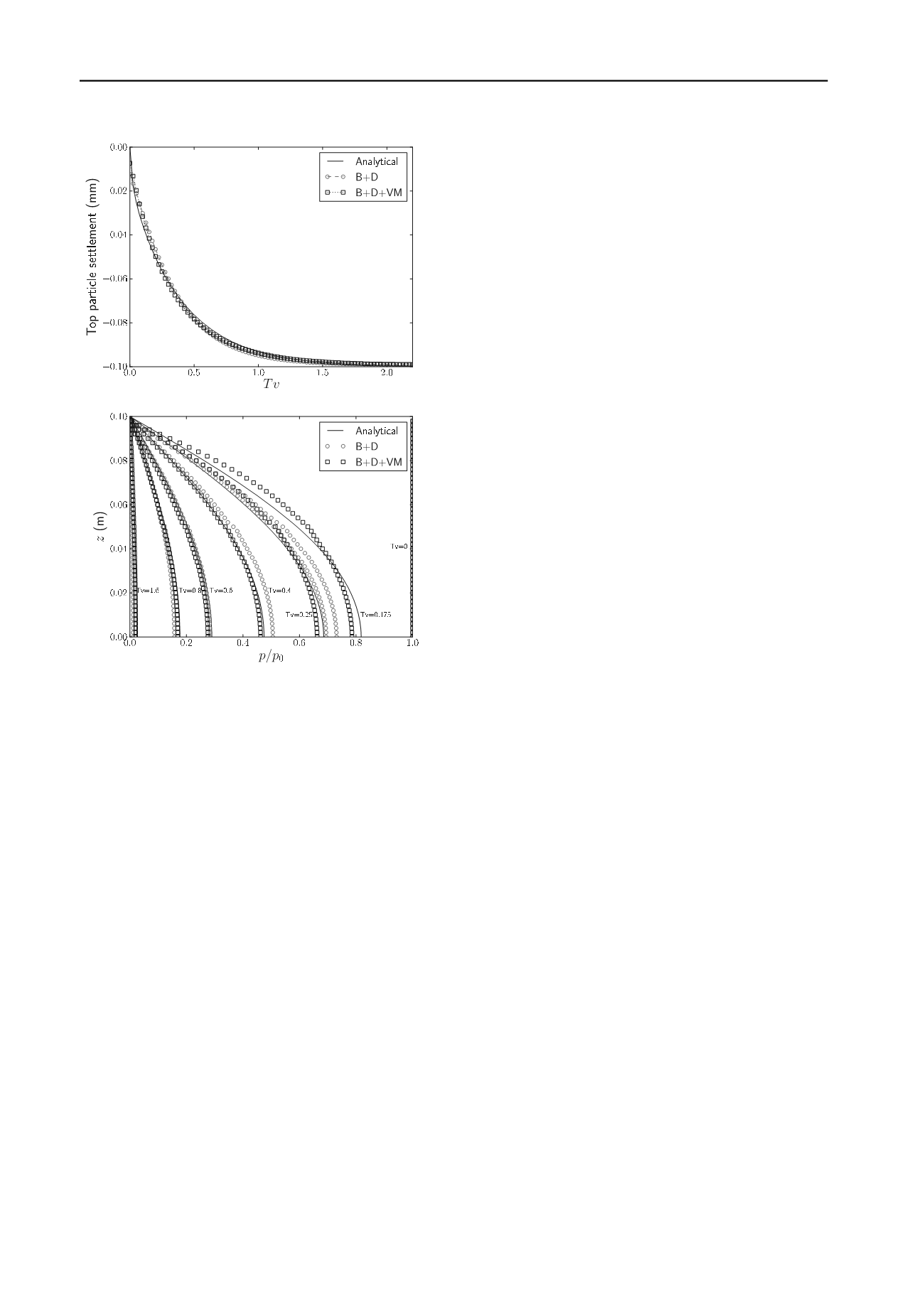
1053
Technical Committee 105 /
Comité technique 105
(a)
(b)
Figure 2. Comparison of the predicted and analytical solutions for 1D
consolidation problem on (a) the top particle settlement (b) the
dissipation of excess pore water pressure.
3.2
Terzaghi’s one dimensional consolidation problem
The numerical tool has also been benchmarked by another
classic soil mechanics problem, one-dimensional consolidation
in a soil layer with one-way drainage, for which Terzaghi
(1943) has developed an analytical solution. In simulating this
1D consolidation problem, we consider a soil column comprised
of 100 equal size spheres saturated in water. The specific model
parameters can be referred to Zhao and Shan (2012a). All
particles are initially placed at the centre line of the column
without any overlap and are emerged in water. The gravitational
force and buoyancy force are then switched on to allow the
particles to settle to a hydrostatic state. Once the initial
consolidation is finished, a surcharge load
p
0
=100 Pa is then
applied at the top of the column. The predicted settlement of the
top particle in the column and the dissipation process of the
excess water pressure are presented in Fig. 2, comparing against
Terzaghi’s analytical solution. As shown in Fig. 2a, the
predicted settlement of the top particle in both CASE I and
CASE II compare well with the analytical solution. There are
some discrepancies, however, in the predicted and analytical
solutions for the excess pore pressure. The differences are
apparently bigger at the initial stage of the loading. The reason
lies in that the analytical solution assumes an instantaneous
buildup of the excess pore pressure throughout the column once
the surcharge is applied, while the CFD-DEM simulation needs
time to build up the whole pore pressure field, which has been
discussed in Zhao and Shan (2012a, b). It is also interesting to
observe that the predictions by CASE II appear to be more
consistent with the analytical solution than by CASE II. This
indicates that more realistic prediction can be made by
considering the virtual mass force.
3.3
Application: sandpiling in water
The two benchmarking problems presented above show that the
coupled CFD-DEM tool is capable of providing reliable
predictions on the fluid-particle interactions for geomechanics-
relevant problem. In this subsection, it is further applied to the
prediction of the behavior of sandpiling in water. The piling of
granular media is commonplace in many engineering branches
and industries, such as the open stockpiles in agriculture,
chemical engineering and mining industries. The angle of
repose and the stress distribution in a sand pile is a focus of
research in the community of both engineering mechanics and
physics. In particular, the pressure minimum in the vertical
stress profile of the base of a sand pile has been an interesting
phenomenon attracting much attention in granular mechanics.
While a dominant body of existing studies on sandpiling has
been focused on the case of dry granular materials, relevant
research on sandpile formation in an environment of water is
rather scarce. This latter case can indeed find useful applications
in practice, ranging from silos to road and dam constructions,
land reclamation and dredging, mine product and tailing
handling. To gain better understanding on the stress
transmission in granular piles submerged in water, the CFD-
DEM approach developed has been employed to examine the
behavior of sandpiling in water (see also Shan and Zhao, 2012;
Zhao and Shan, 2013).
The basic setup the simulation is as follows. A uniform
packing of 15000 sphere particles are poured from a hopper
through a container filled with water to form conical sand piles
on a circular receiving panel with a small round baffle at the
bottom of the container. Fig. 3a demonstrates the setup and the
flowing process of the particles which induces the fluid flow
shown by small arrows in the figure. Fig. 3b depicts the final
state of a stable sand pile formed on the receiving panel. It is
found from the simulation that the repose angle of a sandpile
formed in water is very close to that in the dry case.
Fig. 4 presents the pressure dip observed in a sandpile
formed in water in comparison with the dry case. As compared
to the dry case, the presence of water generally leads to a
flattened pressure dip (or reduced relative pressure). Indicative
information helpful to explain the pressure dip can be obtained
from the contact force network of the sandpile, as is shown in
Fig. 5 for both the dry case (upper figure) and the wet case
(bottom figure). In the dry case, the strong force chains (thicker
columns) show an appreciable orientation with an inward
inclination angle of around 70 degrees. This indicates that the
weights of the upper particles of the sandpile are transferred to
the bottom along these inclined chains rather than along the
vertical direction. The bottom center part of the sandpile is
hence shielded from supporting the weights, which explains the
appreciable pressure dip observed in the dry case. In
comparison, in the wet case shown at the bottom of Fig. 5, the
contact force chains are more preferably oriented to the vertical
direction, and there in no effective shield formed to deflect the
upper weight of the sandpile. This naturally leads to a much
reduced pressure dip in this latter case.
4 CONCLUSIONS
A coupled CFD-DEM approach has been developed to simulate
the interactions between fluid and particle system in granular
media. The DEM has been employed to simulate the motions
and interactions of particles for the granular particle system,
while the CFD has been used to solve the locally averaged
Navier-Stokes equations for the fluid flow. The interactions
between fluids and particles are considered by exchanging


